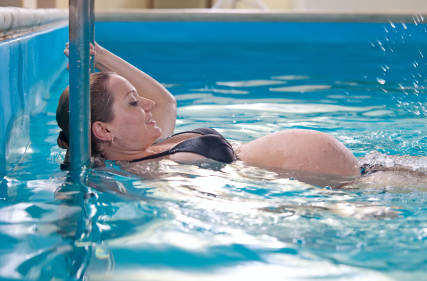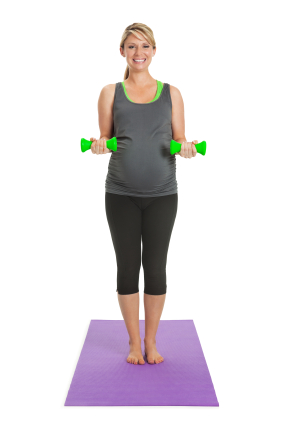Safe and Simple Workouts You Can Stick to While Being Pregnant

The 2 most important things to do when expecting a baby are to keep you and your growing child healthy, and for the mother-to-be to keep moving. Regular exercise throughout pregnancy has been shown to help the mom-to-be have more energy, less back and muscle pain, and a more positive body image. Once the baby is born, mum is able to return to her pre-pregnancy shape a lot more quickly than those who have not exercised.
If you have a regime of exercise and sports prior to becoming pregnant, your exercise level will probably need to be adjusted to suit your pregnant body’s need. Always discuss any form of exercise with your medical practitioner before continuing or starting a new regime.
Swimming
 This has to be one of the best and safest workouts for a pregnant woman. Not only is the body supported as it moves through the water but there is no risk of falling. There is less stress to the joints which are going to be under increased pressure as the baby grows. Swimming will help to keep the body toned. It also raises the heart rate without overheating the body.
This has to be one of the best and safest workouts for a pregnant woman. Not only is the body supported as it moves through the water but there is no risk of falling. There is less stress to the joints which are going to be under increased pressure as the baby grows. Swimming will help to keep the body toned. It also raises the heart rate without overheating the body.
For relief of sore or tight muscles, start by walking across the shallow end of the pool moving your arms through the water as you go for more resistance. Swim up and down the pool at a steady pace, using a paddle board to support the upper body and take breaks as required.
Safety first: Avoid water sports such as diving or water-skiing when pregnant and wear non-slip footwear when walking around the poolside. If you feel any pelvic joint pain, avoid excessive breast stroke kicks and push off evenly from the end when swimming laps.
Pelvic floor exercises
These exercises strengthen and tone the muscles helping to minimise problems with bladder leakage and aiding an easier birth. This involves lifting, squeezing and holding the muscles that surround the vagina and back passage without moving the buttocks, legs or abdominal muscles, and then relaxing them fully. Make sure the bladder is empty and contract the muscles for 5-10 seconds, relax and then repeat with accuracy up to 8 to 12 times. If you find this difficult aim for 3 – 5 in a row. You can do this while sitting in the car waiting at the traffic lights, reading a book or at work sitting at the computer. Some women do need to fully focus and can feel their muscles better when exercising on their hands and knees, or when lying down on their side or sitting on an exercise ball.
For more information on doing pelvic floor exercises during pregnancy visit www.pelvicfloorfirst.org.au
Safety first: One way of locating these muscles is to practice stopping and starting the flow of urine, however do not do this regularly or too often as it could lead to a urinary infection if the bladder is not emptied fully.
Cycling
Gentle cycling is a great way to increase the heart rate while keeping the lower muscles in the body toned up. A bicycle will take the weight of the growing baby and the mother’s weight so there is going to be less stress on the joints. Cycling can also help tone the perineum which is important during the birth of the child. As the pregnancy develops and the abdomen grows, there will be more stress on the back. Keep it straight and start slowly and do not over exert yourself. Around 30 minutes of cycling, 2 or 3 times a week will improve the cardio-respiratory capacity and endurance; both of which will be needed when giving birth.
Safety first: A pregnant woman’s centre of gravity changes during the course of the pregnancy giving rise to a greater risk of falling. It is better to use an exercise cycle or stationary cycle to avoid this risk. Also if you suffer from symphysis pubis problems then you will not be able to ride a bike so always seek medical advice first.
Walking
Walking is a great way to get your heart and lungs working without jarring the ankles and knees. It is completely free and can be fitted in around any routine. If walking was not part of your regular routine before pregnancy, then start with a 15 minute comfortable stroll three times a week. Once in this routine, build up to a 30 minute walk 4 or more times per week. Stop if you feel any pain, tired or unwell.
Safety first: Always take a bottle of water with you and wear a hat and sunscreen if the weather is hot. Ensure you avoid walking during the hottest part of the day. Dehydration will raise the mother’s body temperature and any overheating is not good for the baby nor the pregnant woman.
Yoga
 Yoga helps you to relax and concentrate on your breathing. It also calms both the mind and the body. Breathing exercises in a relaxed and unstressed state of mind are excellent preparation for the mental and physical wellbeing of the mother during labour. If it is not a pre-natal yoga class, make sure that the instructor knows you are pregnant and at which trimester you are at. This is important because during the first, second and third trimester, your body will undergo different changes to adapt the growing baby and to prepare the body for child birth.
Yoga helps you to relax and concentrate on your breathing. It also calms both the mind and the body. Breathing exercises in a relaxed and unstressed state of mind are excellent preparation for the mental and physical wellbeing of the mother during labour. If it is not a pre-natal yoga class, make sure that the instructor knows you are pregnant and at which trimester you are at. This is important because during the first, second and third trimester, your body will undergo different changes to adapt the growing baby and to prepare the body for child birth.
Safety first: Do not do any poses (asanas) on your back after the 1st trimester because they can restrict the flow of blood to the uterus. Avoid poses that stretch the abdominal muscles because as the ligaments soften to prepare the mother’s body, it means a higher risk of strains and muscle pulls. Your yoga instructor will be able to give you a set of exercises that are appropriate for a pregnant woman.
Weight training
 Weight training is another great way to build up stamina and to strengthen the abdominal and back muscles, therefore reducing lower back pain that is common in pregnancy provided correct technique is used. Before doing any weight training, check with your medical practitioner first and make sure to warm up the muscles by marching up and down while swinging your arms.
Weight training is another great way to build up stamina and to strengthen the abdominal and back muscles, therefore reducing lower back pain that is common in pregnancy provided correct technique is used. Before doing any weight training, check with your medical practitioner first and make sure to warm up the muscles by marching up and down while swinging your arms.
There are a number of exercises using weights that are suitable for pregnant women, however one example, which can be carried out in the comfort of your own home, is lateral raises. Start with a weight that is comfortable to lift. Sit up straight on a sturdy chair, feet flat on the floor and knees bent. Hold a dumbbell (3-8 pounds each) in each hand, with hands by the hips. Slightly bend the elbows and lift the arms up to the side but not higher than shoulder height. Repeat this shoulder lateral raise 10-12 times.
Safety first: Avoid weight training while lying on your back as this restricts blood flow to the uterus. When doing any weight training, stop immediately if you feel any discomfort in the joints.
Author’s Bio
Dr. Clarence Ho is a chiropractor and owner of Adaptive Chiropractic and Adaptive Myotherapy. He has been working with pregnant women for over six years. With his great understanding of the pregnant body, he aims to help mothers continue a fitness regime that will not only lead to a happier and healthier pregnancy, but a quicker recovery after giving birth.